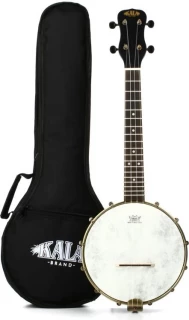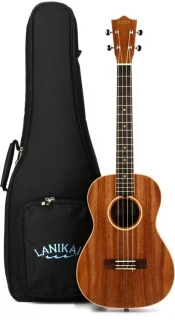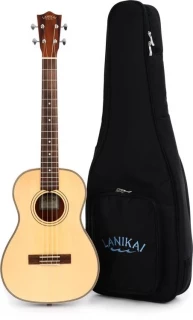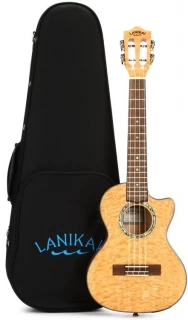Kala Concert Banjo Review
Featured Deal

From $359.00
Get DealKala Concert Banjo
Concert Banjo Ukulele with 5-ply Maple Shell, Mahogany Neck, Walnut Fingerboard, and Remo Weatherking Head- Satin Black
$359.00
$251.30
$323.10
Kala Concert Banjo For Sale
Most Popular Ukuleles
Kala KA-JTE Archtop Tenor
Archtop Tenor Ukulele with Spruce Top, Mahogany Back and Sides, Mahogany Neck,... read more
Ibanez UICT10 Iceman Tenor
Tenor Ukulele with Spruce Top, Okoume Body, Okoume Neck, Purpleheart Fingerboard and... read more
Lanikai ACST-B Acacia Baritone
Baritone Ukulele with Acacia Top and Body and Walnut Fingerboard - Natural read more
Lanikai SPST-B Spruce Solid Top, Morado Back and Sides
Baritone Ukulele with Spruce Top, Morado Body, and Walnut Fingerboard - Natural read more
Lanikai QM-NACET Tenor with Cutaway & Electronics
Tenor Cutaway Ukulele with Maple Body, Walnut Fingerboard, and Kula Electronics -... read more
Specifications |
|||
|---|---|---|---|
| Brand | Kala | ||
| Category | Ukuleles | ||
| Size: | Concert, | ||
| Number of Strings: | 4, | ||
| Color: | Black, | ||
| Finish: | Satin, | ||
| Top Material: | Remo Weatherking banjo head, | ||
| Back & Sides Material: | 5-ply Maple, | ||
| Binding Material: | Cream, | ||
| Neck Material: | Mahogany, | ||
| Fingerboard Material: | Walnut, | ||
| Fingerboard Inlay: | Maple Dots, | ||
| Number of Frets: | 18, | ||
| Scale Length: | 15.5", | ||
| Tuners: | Open Gear Vintage Tuners, | ||
| Nut Material: | Bone, | ||
| Nut Width: | 1.375", | ||
| Saddle Material: | Maple/Ebony Cap, | ||
| Strings: | Kala Fluorocarbon, | ||
| Case Included: | Gig Bag, | ||
| Overall Length: | 25.25", | ||
| Manufacturer Part Number: | KA-BNJ-C, | ||
Daily Deals
Kala Concert Banjo Sizes
Kala Concert Banjo Reviews
Kala Banjolele is OK, but there are better instruments out there.
The Kala Banjolele is nothing special. It's cheap, but attractive in an industrial-looking way. It's primitive in that the neck has virtually NO adjustment for action (can't move it forward or backward in relation to the banjo body), although removing the neck and machining it is a possibility. The neck has good heft and thickness, but the finish is rather rough, and the nut width… read more is quite narrow and tight. The geared tuners really beg for you to replace them with Gotoh UPT tuners, more in keeping with the instrument and much quicker tuning, once you get used to them. Overall, Kala had a good idea that wasn't taken far enough. The back panel on mine is more oblong than round, and that is unfortunate given that the banjo body it is fitted on is much more round than oblong... Take the back off and then struggle to align it properly for reattachment, guys! You can do it, but it may take a while. The frets and fretboard look OK, but something about its manufacture makes it difficult to get clear sounding chords when playing, and the lack of a compensated banjo bridge means getting near-perfect intonation is impossible. So then, we have a basic banjolele that could use some reworking to make it better. If only the thing had good tone, that would make its many drawbacks more acceptable, but the actual sound of this instrument is rather poor. You get a decent plunk, but the sound is not particularly pleasant. As a matter of fact, after playing this Banjolele exclusively for several weeks, I put it down for a bit and began playing my Kamaka Tenor Ukulele, and was amazed at how much better the Kamaka sounded. It was positively angelic when compared to the foul-sounding Kala Banjolele. Of course, the two instruments use different materials and construction techniques, but man, the tone of this Kala is dreadful! I'm not giving up on it, though, and I intend to try different string sets and hopefully, a compensated bridge, to get better sound quality. I'm quite sure Martin Fluorocarbon strings will provide somewhat better tone, and Kamaka Black Nylon strings, which are rather high tension, would provide more banjo-like plunk. So then, the Kala is primitive, cheaply built, needs improvements in playability and sound quality, but it does have one good feature; it's a fun toy! As awful as it is, you want to keep playing it. Kala gives you a minimally protective dust cover/gig bag with it.
Excellent
Superb and well crafted Uke. Because it feels and plays like a banjo it just seems to add to playing pleasure . . .and I like Ukes (I have 7 of them).
Kala Concert Banjo Questions and Answers
No Questions Yet.












